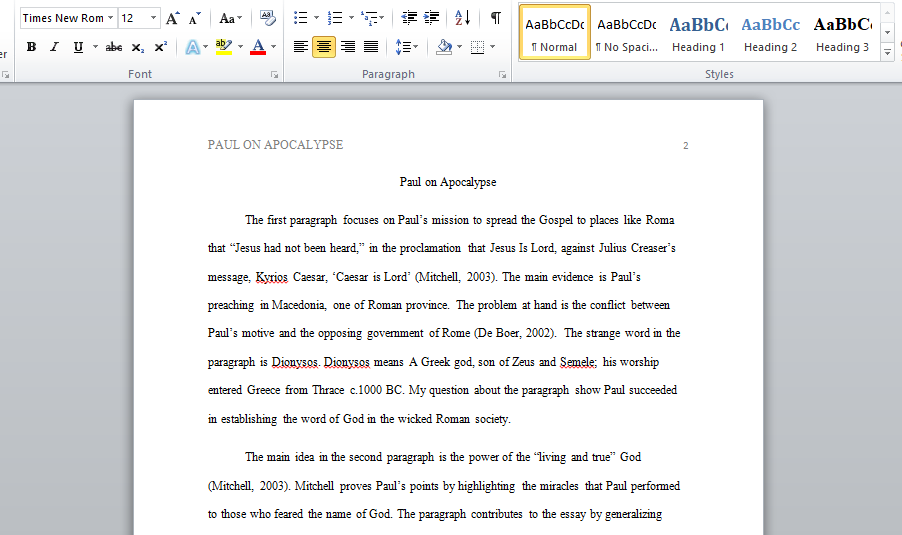Discuss what Paul wrote on Apocalypse
Discuss what Paul wrote on Apocalypse.Margaret M. Mitchell’s “1 & 2 Thessalonians” is real-world example of rhetorical analysis, and a useful model you should refer to as you work on the RA. This week, our goals are to:
1) Understand and analyze academic writing conventions,
2) Practice more explicitly strategies for critical reading and note-taking for argument as described on the Metacognitive Tools for Critical Reading page, and
3) Understand and analyze an example of rhetorical argument.
The following exercise asks you to create a “reverse outline,” which should help you read for structure and logical relationships, not just content (although there’s plenty of useful content about Paul’s letters to the Thessalonians as well). Please follow the directions carefully.
1) For each paragraph in Mitchell’s essay, write a ONE-SENTENCE paraphrase of the main idea. Number your list—there should be 27 sentences total.
2) Below EACH main idea, briefly summarize in your own words the main evidence the writer uses to support the main idea and label what kind of evidence this is. (For example, historical description, explanation/definition of key concept, quotation/summary from primary source, argument from secondary source). BE SPECIFIC (1-2 sentences).
3) Next, describe how EACH paragraph contributes to the essay as a whole. In other words, what’s the purpose of each paragraph? For example:
- Introducing, defining, or explaining an important concept
- Providing background information (historical, cultural, intellectual context)
- Articulating a claim (thesis or supporting idea)
- Qualifying a claim (setting or conceding limits to the main idea)
- Analyzing or interpreting examples (from primary source or historical record)
- Citing an authority (argument from secondary source)
- Responding to an authority (counter-argument, rebuttal)
- Making a comparison (analysis)
- Making a generalization (analysis)
- Making an inference (X signals or implies Y–analysis)
- Establishing cause/effect (analysis)
- Transitioning to a new idea
- Explaining the argument’s significance (“the stakes” or “so what?”)
4) Next, choose one or more of the metacognitive categories to describe your response to EACH paragraph. See the Metacognitive Tools for Critical Reading. What were you thinking as you read each paragraph?
5) Write down any unfamiliar words or ideas and look them up. Copy/paste the definition of each unfamiliar word.
6) Write down any questions you have about the paragraph.
After you’ve created your reverse outline of the essay, reflect on what you’ve learned about academic writing during this process. Answer the following questions:
7) Pick a passage (outside the two intro paragraphs) where you think Mitchell transitions between ideas in a relatively clear way. Give us the paragraph numbers and explain how she creates this transition. How does she select specific words or use specific sentence structures in order to make this transition between ideas clear?
8) Mitchell’s article belongs to the genre of academic essay, which is written by a scholar for an audience of fellow scholars (in this case, religious studies). List at least five rhetorical strategies (or conventions of academic writing) that Mitchell uses to establish her credibility/authority as an expert and persuade her audience of fellow experts.
*Hint: Scholars not only care about the quality of a writer’s ideas, but also the quality of the evidence supporting those ideas, and how that evidence is gathered, presented, and treated.
Answer preview:

Words:3126
